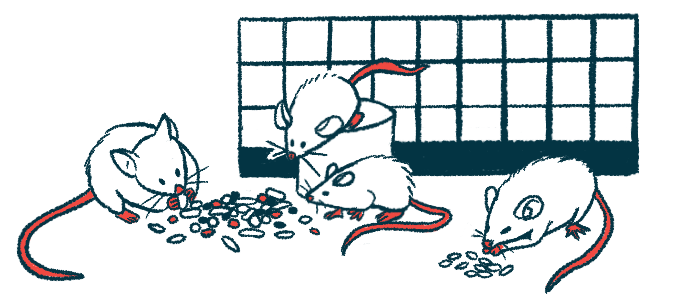Targeting CB1Rs restores brain energy production in Rett mice
High levels of such receptors may be linked to cognitive deficits: Study
Written by |

Increased levels of CB1 cannabinoid protein receptors, known as CB1Rs, may be tied to dysfunction of the brain’s mitochondria — its cellular energy-producing compartments — and to cognitive deficits in Rett syndrome, according to a study in a mouse model.
The study also reported that blocking CB1Rs in the brain, where these receptors help regulate learning and memory, improved energy production and cognitive function in the Rett mice.
These “results identify the overexpression of [mitochondrial CB1R] as a molecular signature to be pharmacologically modulated … in [Rett],” the researchers wrote.
Further, the team noted that “the translational relevance of this observation is stressed by the fact that CB1R [inhibition] is under active scrutiny at the clinical level as a promising target to rescue cognitive defects in syndromic intellectual disability disorders.”
Titled “Pharmacological inhibition of the CB1 cannabinoid receptor restores abnormal brain mitochondrial CB1 receptor expression and rescues bioenergetic and cognitive defects in a female mouse model of Rett syndrome,” the study was published in the journal Molecular Autism.
Changes in brain energy production found to play a role in Rett
In most cases, Rett syndrome is caused by mutations in the MECP2 gene, which provides instructions to make a protein that regulates the activity of other genes. That protein essentially switches other genes on or off, playing a key role in brain development and function.
Rett syndrome is more common in females, primarily diagnosed in girls during infancy, and is characterized by problems in cognitive, motor, sensory, and emotional skills. Symptoms typically start early in life, between the ages of 6 to 18 months.
Dysfunction of mitochondria and oxidative stress — cell damage caused by reactive oxygen species, or unstable oxygen-containing molecules — are thought to play a role in the development of Rett.
“Although accumulating evidence suggests that targeting mitochondrial function may be beneficial to contrast [Rett] symptomatology, the mechanisms underlying mitochondrial impairments are still unclear,” the scientists wrote.
To learn more, the team used a female mouse model of Rett to assess whether mitochondrial changes in the disease could be associated with excessive activation of CB1R located in the brain’s mitochondrial membrane, which is involved in energy production.
Compared with control animals, the Rett mice had higher levels of mitochondrial CB1R, which normalized after treatment with a CB1R inverse agonist called rimonabant. An inverse agonist binds to a protein receptor to reduce its activity.
Also, the activity of a CB1R target called protein kinase A, which was decreased in the mitochondria of Rett mice, increased with rimonabant treatment.
Even though further studies are needed, these findings put mitochondria in the spotlight as a valuable source of unexplored therapeutic targets for the treatment of [Rett].
Next, the researchers analyzed whether the normalization of CB1R levels in rimonabant-treated mice could rescue brain mitochondrial function and reduce oxidative stress. The team found that the treatment indeed improved mitochondrial function and energy production, restoring a normal energetic status in the brain, while normalizing the production of reactive oxidizing species.
In addition, rimonabant improved the spatial memory of Rett mice — a cognitive process impaired in Rett that is needed to remember where an object is located and move in an environment.
Spatial memory was assessed by the object location test, which determines whether an animal shows a preference for a novel location over a familiar one, as occurs with healthy controls.
Overall, the Rett mice’s health condition was impaired, and they showed additional symptoms like abnormal gait, reduced mobility, and breathing problems. These mice also showed excessive rounding of the back, tremors, and seizures. However, treatment with rimonabant did not significantly improve the animals’ general health status.
“Additional investigation is necessary to validate this subcellular pool of CB1R as novel druggable targets with therapeutic potential for [Rett] and confirm the generalizability of our findings to other syndromic intellectual disability disorders characterized by mitochondrial dysfunctions,” the researchers wrote.
According to the scientists, this work in mice highlights the importance of the role of energy production in the brain as a focus for future research.
“Even though further studies are needed, these findings put mitochondria in the spotlight as a valuable source of unexplored therapeutic targets for the treatment of [Rett] … and open to the implementation of innovative targeted interventions,” the researchers concluded.






